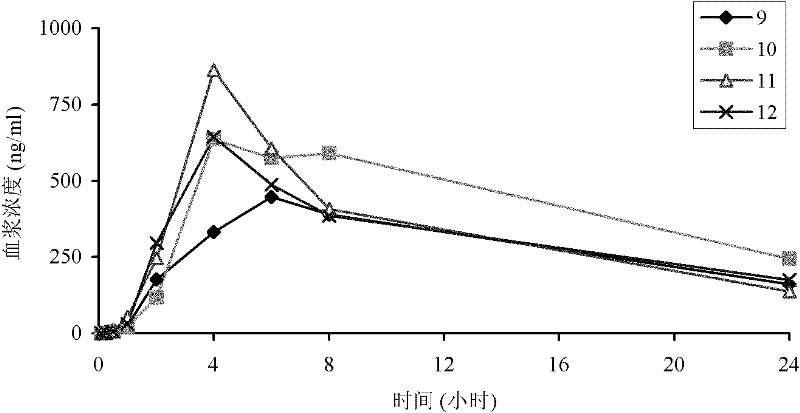Method for preparing deuterated diphenyl urea
A kind of technology of diphenylurea and trideuterated methyl group is applied in the field of intermediates for preparing deuterated diphenylurea, which can solve the problems of low yield, high cost, difficult separation and the like
- Summary
- Abstract
- Description
- Claims
- Application Information
AI Technical Summary
Problems solved by technology
Method used
Image
Examples
preparation example 1
[0118] (1) Synthesis of intermediate N-(1,1,1-trideuteromethyl)benzosuccinimide
[0119]
[0120] 1: Preparation of 4-methylbenzenesulfonic acid-(1,1,1-trideuteromethyl)ester
[0121] Sodium hydroxide (180g, 4.5mol, 5.0eq) was added to water (288mL), at 0°C, deuterated methanol (32.4g, 900mmol, 1.0eq) was added, and p-toluenesulfonyl chloride (206g , 1.1 mmol, 1.2 eq) in tetrahydrofuran (288 mL). Warm to room temperature and stir overnight. Add acetic acid (206g) dropwise below 25°C to neutralize, filter the reaction mixture, separate the layers, extract the water layer with ethyl acetate (100mL), dissolve the filter cake with water (300mL), and extract with ethyl acetate ( 200 mL) and the organic phase was washed with saturated sodium carbonate (100 mL), washed with saturated brine (100 mL), the organic phase was dried over anhydrous sodium sulfate, filtered, and the solvent was removed under reduced pressure to obtain the title compound as light yellow liquid 160.5 g, ...
preparation example 2
[0130] Preparation of intermediate N-(1,1,1-trideuteromethyl)benzosuccinimide
[0131]
[0132] 1: Preparation of N-(1,1,1-trideuteromethyl)benzosuccinimide
[0133] Step 2 of Example 1 was repeated, except that the potassium phthalimide salt was replaced with phthalimide (5.9 g, 40 mmol, 2.0 eq), and hydroxide was added in batches at 0° C. Potassium solid (2.2g, 40mmol, 2.0eq), after stirring for 30 minutes, 4-methylbenzenesulfonic acid-(1,1,1-trideuteromethyl)ester (3.8g, 20mmol, 1.0eq) was added dropwise DMF (10 mL) solution, the temperature was raised to 60° C. and stirred for 30 minutes after the dropwise addition. Filtration, washing and vacuum drying were performed in the same manner to obtain the title compound as a white solid, 2.1 g, with a purity of 81%, and a yield of about 62%.
preparation example 3
[0135]
[0136] 1: Preparation of N-(1,1,1-trideuteromethyl)benzosuccinimide
[0137] Step 2 of Example 1 was repeated except that phthalimide potassium salt was replaced with phthalimide (5.9 g, 40 mmol, 2.0 eq), and sodium hydride was added in batches at 0° C. (80%, 1.2g, 40mmol, 2.0eq), after stirring for 30 minutes, 4-methylbenzenesulfonic acid-(1,1,1-trideuteromethyl)ester (3.8g, 20mmol, 1.0eq ) in DMF (10 mL), after the dropwise addition was completed, the temperature was raised to 60° C. and stirred for 30 minutes. Filtration, washing and vacuum drying were performed in the same manner to obtain the title compound as a white solid, 2.7 g, with a purity of 86% and a yield of 80%.
[0138] It can be seen from the above experiments that the above three methods can all prepare the new intermediate N-(1,1,1-trideuteromethyl)benzosuccinimide. However, using phthalimide potassium salt as an intermediate, compared with the production process using phthalimide+potassium hyd...
PUM
| Property | Measurement | Unit |
|---|---|---|
| melting point | aaaaa | aaaaa |
Abstract
Description
Claims
Application Information
 Login to View More
Login to View More - R&D
- Intellectual Property
- Life Sciences
- Materials
- Tech Scout
- Unparalleled Data Quality
- Higher Quality Content
- 60% Fewer Hallucinations
Browse by: Latest US Patents, China's latest patents, Technical Efficacy Thesaurus, Application Domain, Technology Topic, Popular Technical Reports.
© 2025 PatSnap. All rights reserved.Legal|Privacy policy|Modern Slavery Act Transparency Statement|Sitemap|About US| Contact US: help@patsnap.com



